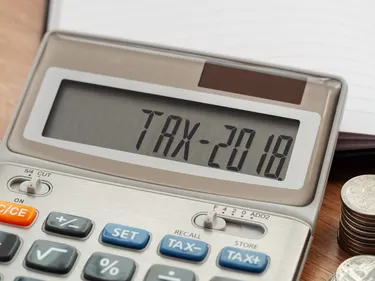
The Internal Revenue Service (IRS) allows three years from the due date for a taxpayer to file an income tax return. The final date to file a 2018 tax return is fast approaching. You may be eligible for a refund check and not know it.
If you haven't filed your individual income tax return for tax year 2018, you have until April 18, 2022, to file a 1040 Form. For those filers living in Maine and Massachusetts, the filing deadline is April 19, 2022. You must file with the 2018 1040 Form. You cannot file for 2018 after the upcoming due date and receive an income tax refund.
Video of the Day
Video of the Day
$1.5 Billion in Unclaimed 2018 Tax Refunds
Millions of taxpayers are missing out on a tax refund. According to the IRS, $813 is the mid-point for the refund amount of each individual. That means that half the taxpayers are owed less and the other half are due more than $813.
But your 2018 refund check may be held if you have not filed tax returns for 2019 and 2020. Any refund will be applied to any prior year taxes, unpaid child support or student loans.
Consider also: Check Out These Tax Tips Direct From the IRS
Losing Earned Income Tax Credit for 2018
Besides the withheld tax from your paycheck that might be returned, taxpayers risk losing the Earned Income Tax Credit (EITC).
Many low- and moderate-income taxpayers are eligible for the EITC. This credit for 2018 is worth up to $6,431. You lose this credit and, therefore, this potential refund by not filing an income tax return.
Child Tax Credit Possible
If you have a child dependent under 17 years old, you may be eligible for the Child Tax Credit (CTC). For 2018, the maximum credit is $2,000 per qualifying child. Each child claimed must have a Social Security number or an individual tax identification number (ITIN).
There is also the Additional Child Tax Credit (ACTC). This credit makes you eligible for a refund even if you don't owe any tax. This is in addition to the CTC.
Millions of taxpayers are missing out on a tax refund.
Finding Out if You’re Owed a Refund
In order to find out if you're owed a refund, a 2018 tax return must be filed. Unfortunately, the IRS tool Where's My Refund will only help you if you've already filed a federal income tax return.
Filing 2018 Tax Return
Although you can do your tax preparation with tax software from H&R Block and TurboTax, you can't e-file your return. Instead, you'll need to print and mail your 2018 tax return. This must be mailed to your regional IRS office. Your regional office is based on geographic location and can be found on the back of the 2021 1040 Form.
Consider also: How to File Taxes From Previous years
Finding Tax Documents
Go to the IRS.gov forms page to find any forms needed to file. You will also need your 2018 personal tax forms such as a W-2, 1098, 1099 or 5498. Your 2018 employer, bank or any other payer should have these.
If you have missing forms and can't get them, order a free income and wage transcript from IRS.gov. Use the Get Transcript Online and request a wage and income transcript.
Consider also: Filing Your Income Tax Return
Direct Deposit Means a Fast Refund
Despite having to file your 2018 federal income tax form by mail, direct deposit into your bank account or debit card is still possible. The refund section at the bottom of the return gives you the choice of receiving a paper check or a direct deposit refund.
- IRS: IRS has $1.5 Billion in Refunds for People Who Have Not Filed a 2018 Federal Income Tax Return; April Deadline Approaches
- eFile: Unclaimed Income Tax Refunds by Taxpayers
- cnet: 1.5 Million Taxpayers have Unclaimed Tax Refunds: How to Get that IRS Money
- IRS: Credit Child Tax Credit and Credit for Other Dependents
- IRS: Forms, Instructions, Publications